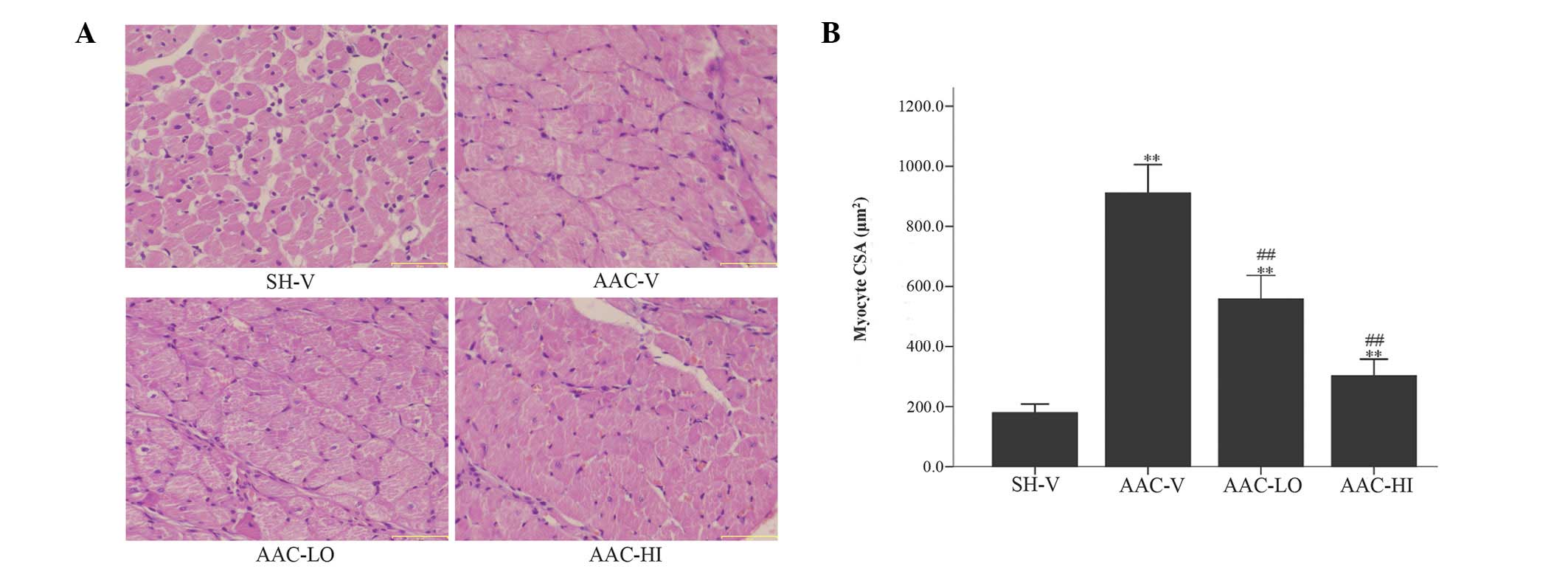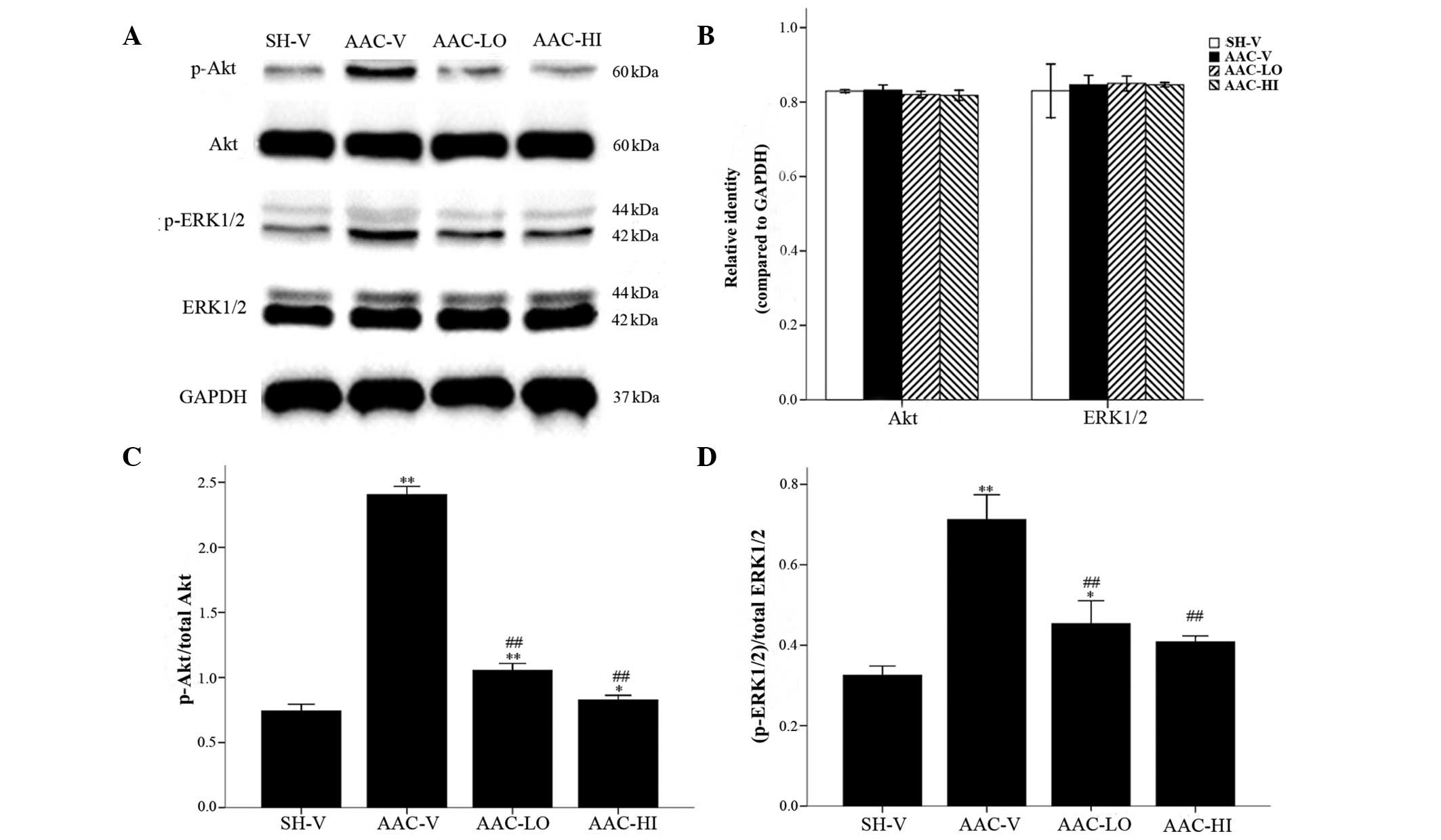|
1
|
Levy D, Garrison RJ, Savage DD, Kannel WB
and Castelli WP: Prognostic implications of echocardiographically
determined left ventricular mass in the Framingham Heart Study. N
Engl J Med. 322:1561–1566. 1990. View Article : Google Scholar : PubMed/NCBI
|
|
2
|
Okin PM, Devereux RB, Jern S, et al:
Regression of electrocardiographic left ventricular hypertrophy
during antihypertensive treatment and the prediction of major
cardiovascular events. JAMA. 292:2343–2349. 2004. View Article : Google Scholar : PubMed/NCBI
|
|
3
|
Auer J, Berent R, Weber T and Eber B:
Clinical significance of pleiotropic effects of statins: lipid
reduction and beyond. Curr Med Chem. 9:1831–1850. 2002. View Article : Google Scholar : PubMed/NCBI
|
|
4
|
Laufs U, Fata VL and Liao JK: Inhibition
of 3-hydroxy-3-methylglutaryl (HMG)-CoA reductase blocks
hypoxia-mediated down-regulation of endothelial nitric oxide
synthase. J Biol Chem. 272:31725–31729. 1997. View Article : Google Scholar : PubMed/NCBI
|
|
5
|
Fukumoto Y, Libby P, Rabkin E, et al:
Statins alter smooth muscle cell accumulation and collagen content
in established atheroma of watanabe heritable hyperlipidemic
rabbits. Circulation. 103:993–999. 2001. View Article : Google Scholar : PubMed/NCBI
|
|
6
|
Ridker PM, Rifai N, Clearfield M, et al:
Measurement of C-reactive protein for the targeting of statin
therapy in the primary prevention of acute coronary events. N Engl
J Med. 344:1959–1965. 2001. View Article : Google Scholar
|
|
7
|
Planavila A, Laguna JC and Vázquez-Carrera
M: Atorvastatin improves peroxisome proliferator-activated receptor
signaling in cardiac hypertrophy by preventing nuclear factor-kappa
B activation. Biochim Biophys Acta. 1687:76–83. 2005. View Article : Google Scholar
|
|
8
|
Young ME, Laws FA, Goodwin GW and
Taegtmeyer H: Reactivation of peroxisome proliferator-activated
receptor alpha is associated with contractile dysfunction in
hypertrophied rat heart. J Biol Chem. 276:44390–44395. 2001.
View Article : Google Scholar : PubMed/NCBI
|
|
9
|
Takemoto M, Node K, Nakagami H, et al:
Statins as antioxidant therapy for preventing cardiac myocyte
hypertrophy. J Clin Invest. 108:1429–1437. 2001. View Article : Google Scholar : PubMed/NCBI
|
|
10
|
Kameda Y, Hasegawa H, Kubota A, et al:
Effects of pitavastatin on pressure overload-induced heart failure
in mice. Circ J. 76:1159–1168. 2012. View Article : Google Scholar : PubMed/NCBI
|
|
11
|
Xu R, Lin F, Zhang S, Chen X, Hu S and
Zheng Z: Signal pathways involved in reverse remodeling of the
hypertrophic rat heart after pressure unloading. Int J Cardiol.
143:414–423. 2010. View Article : Google Scholar : PubMed/NCBI
|
|
12
|
Esposito G, Prasad SV, Rapacciuolo A, Mao
L, Koch WJ and Rockman HA: Cardiac overexpression of a G(q)
inhibitor blocks induction of extracellular signal-regulated kinase
and c-Jun NH(2)-terminal kinase kinase activity in in vivo pressure
overload. Circulation. 103:1453–1458. 2001. View Article : Google Scholar
|
|
13
|
van Berlo JH, Elrod JW, Aronow BJ, Pu WT
and Molkentin JD: Serine 105 phosphorylation of transcription
factor GATA4 is necessary for stress-induced cardiac hypertrophy in
vivo. Proc Natl Acad Sci USA. 108:12331–12336. 2011.PubMed/NCBI
|
|
14
|
Siri FM: Chronic norepinephrine infusion
and adrenergic function of hypertrophied hearts. Am J Physiol.
248(4 Pt 2): H485–H492. 1985.PubMed/NCBI
|
|
15
|
Teichholz LE, Kreulen T, Herman MV and
Gorlin R: Problems in echocardiographic volume determinations:
echocardiographic-angiographic correlations in the presence of
absence of asynergy. Am J Cardiol. 37:7–11. 1976.
|
|
16
|
Leskinen H, Rauma-Pinola T, Szokodi I, et
al: Adaptive or maladaptive response to adenoviral adrenomedullin
gene transfer is context-dependent in the heart. J Gene Med.
10:867–877. 2008. View
Article : Google Scholar : PubMed/NCBI
|
|
17
|
Woodiwiss AJ, Tsotetsi OJ, Sprott S, et
al: Reduction in myocardial collagen cross-linking parallels left
ventricular dilatation in rat models of systolic chamber
dysfunction. Circulation. 103:155–160. 2001. View Article : Google Scholar : PubMed/NCBI
|
|
18
|
Hong Y, Hui SC, Chan TY and Hou JY: Effect
of berberine on regression of pressure-overload induced cardiac
hypertrophy in rats. Am J Chin Med. 30:589–599. 2002. View Article : Google Scholar : PubMed/NCBI
|
|
19
|
Ni L, Zhou C, Duan Q, et al: β-AR blockers
suppresses ER stress in cardiac hypertrophy and heart failure. PLoS
One. 6:e272942011.
|
|
20
|
Li J, Li P, Feng X, et al: Effects of
losartan on pressure overload-induced cardiac gene expression
profiling in rats. Clin Exp Pharmacol Physiol. 30:827–832. 2003.
View Article : Google Scholar : PubMed/NCBI
|
|
21
|
Zhou MS, Jaimes EA and Raij L:
Atorvastatin prevents end-organ injury in salt-sensitive
hypertension: role of eNOS and oxidant stress. Hypertension.
44:186–190. 2004. View Article : Google Scholar
|
|
22
|
Takayama N, Kai H, Kudo H, et al:
Simvastatin prevents large blood pressure variability induced
aggravation of cardiac hypertrophy in hypertensive rats by
inhibiting RhoA/Ras-ERK pathways. Hypertens Res. 34:341–347. 2011.
View Article : Google Scholar : PubMed/NCBI
|
|
23
|
Habibi J, Whaley-Connell A, Qazi MA, et
al: Rosuvastatin, a 3-hydroxy-3-methylglutaryl coenzyme a reductase
inhibitor, decreases cardiac oxidative stress and remodeling in
Ren2 transgenic rats. Endocrinology. 148:2181–2188. 2007.
View Article : Google Scholar : PubMed/NCBI
|
|
24
|
Choi EY, Chang W, Lim S, et al:
Rosuvastatin inhibits norepinephrine-induced cardiac hypertrophy
via suppression of Gh. Eur J Pharmacol. 627:56–62. 2010. View Article : Google Scholar : PubMed/NCBI
|
|
25
|
Chang SA, Kim YJ, Lee HW, et al: Effect of
rosuvastatin on cardiac remodeling, function, and progression to
heart failure in hypertensive heart with established left
ventricular hypertrophy. Hypertension. 54:591–597. 2009. View Article : Google Scholar : PubMed/NCBI
|
|
26
|
Chaanine AH and Hajjar RJ: AKT signalling
in the failing heart. Eur J Heart Fail. 13:825–829. 2011.
View Article : Google Scholar : PubMed/NCBI
|
|
27
|
Liang Q, Wiese RJ, Bueno OF, Dai YS,
Markham BE and Molkentin JD: The transcription factor GATA4 is
activated by extracellular signal-regulated kinase 1- and
2-mediated phosphorylation of serine 105 in cardiomyocytes. Mol
Cell Biol. 21:7460–7469. 2001. View Article : Google Scholar : PubMed/NCBI
|
|
28
|
Tenhunen O, Sármán B, Kerkelä R, et al:
Mitogen-activated protein kinases p38 and ERK 1/2 mediate the wall
stress-induced activation of GATA-4 binding in adult heart. J Biol
Chem. 279:24852–24860. 2004. View Article : Google Scholar : PubMed/NCBI
|
|
29
|
Condorelli G, Drusco A, Stassi G, et al:
Akt induces enhanced myocardial contractility and cell size in vivo
in transgenic mice. Proc Natl Acad Sci USA. 99:12333–12338. 2002.
View Article : Google Scholar : PubMed/NCBI
|
|
30
|
Morisco C, Seta K, Hardt SE, Lee Y, Vatner
SF and Sadoshima J: Glycogen synthase kinase 3beta regulates GATA4
in cardiac myocytes. J Biol Chem. 276:28586–28597. 2001. View Article : Google Scholar : PubMed/NCBI
|
|
31
|
Smeets PJ, Teunissen BE, Willemsen PH, et
al: Cardiac hypertrophy is enhanced in PPAR alpha−/− mice in
response to chronic pressure overload. Cardiovasc Res. 78:79–89.
2008.
|
|
32
|
Miyamoto T, Takeishi Y, Takahashi H, et
al: Activation of distinct signal transduction pathways in
hypertrophied hearts by pressure and volume overload. Basic Res
Cardiol. 99:328–337. 2004.PubMed/NCBI
|
|
33
|
Yang D, Ma S, Tan Y, et al: Adrenergic
receptor blockade-induced regression of pressure-overload cardiac
hypertrophy is associated with inhibition of the
calcineurin/NFAT3/GATA4 pathway. Mol Med Rep. 3:497–501. 2010.
View Article : Google Scholar : PubMed/NCBI
|


















